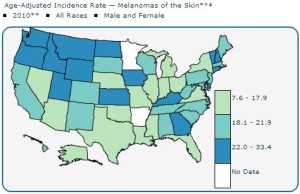
Did you know your risk of getting cancer is not based solely on genetics? That’s good news! We’ve compiled seven everyday steps you can take to proactively reduce your risk of ever getting a cancer diagnosis.
- It’s a cover up! Protect your skin when outside by wearing a wide-brimmed hat, slathering on lots of sunscreen, and wearing tightly woven fabrics. Wear dark colored clothing as it blocks UV rays much better than lighter colors. Also, avoid tanning beds and heat lamps. If you should notice any new spots on your skin or changes in moles, see your doctor right away!
- Kick your tobacco habit to the curb!. We’ve known about the association of cancer and tobacco for decades. Smoking not only increases the risk of lung cancer, but cancer of the throat, mouth, larynx, bladder, kidney, pancreas, and cervix. Chewing tobacco also increases one’s risk of oral and pancreatic cancer. Tobacco is linked to about 80% off all lung cancer deaths and comprises about 30% of all cancer deaths.
- Drink responsibly. Alcohol increases the risk for many types of cancer including, liver, colon, breast, and esophagus. It is generally recommended that men consume no more than two drinks per day and that women consume no more than one. Five ounces of wine, 12 ounces of wine, or 1½ ounces of 80-proof liquor equals one drink.
- Mom was right–eat your vegetables. Diet has been linked to prostate, breast, and colon cancers as well as other types of cancer. A diet rich in organic nutrients is thought to reduce this risk. However, eating right can be confusing. The American Institute for Cancer research’s (AIRC) new American Plate menu makes eating right simple by recommending two-thirds of your plate hold fruits, vegetables, beans, and whole grains with the other one-third consist of lean meats, fish, and low-fat dairy
- Move your body! The American Cancer Society and the Mayo Clinic recommend 150 minutes of moderate exercise per week (such as brisk walking) or 75 minutes of vigorous exercise (the kind that makes you sweat and breathe faster). Doing so can reduce the risk of breast, colon, prostate, and endometrium cancer. As an added benefit, exercise can also reduce your risk for heart disease and diabetes.
- Belly up to the water faucet. Drinking plenty of water may reduce your risk of bladder cancer by diluting cancer causing agents and flushing them out of your system. The American Cancer society recommends drinking at least eight glasses of high-quality water a day. Studies have also shown that filtered tap water is better for you than bottled water as filtered water reduces carcinogens. All bottled water is not created equal, and sometimes the quality of bottled water is lower than filtered municipal tap water. Do not store your water in plastic containers, but instead use stainless steel or glass to avoid chemical contaminants such as BPA that can leach from plastic bottles.
- Have your coffee and drink it, too! A British study in 2010 showed that folks who drank five cups or more of caffeinated coffee decreased their risk of brain cancer by 40% when compared with people who drank the less. This amount of coffee also reduced the risk cancers of the mouth and pharynx by almost as much. Caffeinated tea also reduced the risk of these cancers, but not as much as java.
Hopefully, by following these seven steps, you will spend a lifetime being cancer-free.
For more information:




